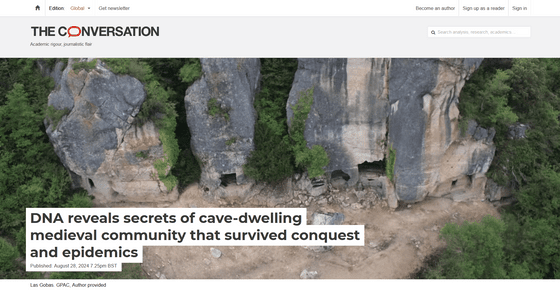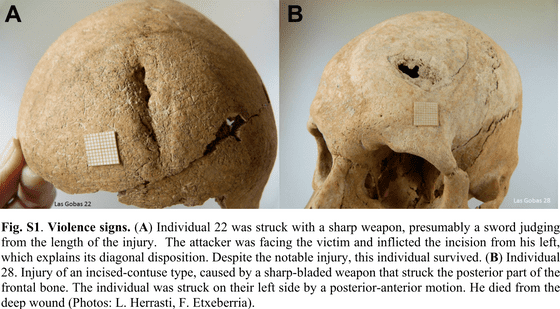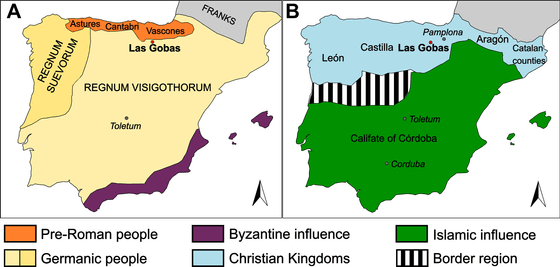Examination of medieval Spanish Christian cave reveals signs of inbreeding, violence

Located in the province of Treviño in the province of Burgos in northern Spain, there is the Las Gobas archaeological site, the remains of a medieval Christian settlement in a cave carved into the rock face. Examination of remains excavated from this cave revealed that the people who lived in this remote area at that time experienced epidemics and bloodshed caused by swords.
Five centuries of consanguinity, isolation, health, and conflict in Las Gobas: A Northern Medieval Iberian necropolis | Science Advances
DNA reveals secrets of cave-dwelling medieval communities that survived conquest and epidemics
https://theconversation.com/dna-reveals-secrets-of-cave-dwelling-medieval-community-that-survived-conquest-and-epidemics-235936

It is said that the Las Gabos ruins were inhabited from the mid-6th century to around the 11th century, and they offer a glimpse into the lives of people who lived away from urban areas before and after the Iberian Peninsula was taken over by Islamic forces.
In addition, the remains of 41 people have been excavated from a nearby cemetery, and genetic analysis of 39 of them has been carried out. Analysis has confirmed the gender of 33 people (22 men and 11 women), and DNA has been obtained from a further 28 people for further investigation.
First, although this region is located at the northern end of the Islamic-controlled area of the Iberian Peninsula, known as
Two of the remains dating back to the early settlement showed signs of violence, likely caused by blows to the head with a sword. The two were genetically related, and surprisingly, one of them survived for some time despite being seriously injured, with a blade piercing his skull. The sword attacks on both men occurred before the Muslims conquered the region, so the wounds sustained by the two were not likely from fighting Islam.
Below, the skull on the left is of a person who survived after suffering serious head injuries, and the skull on the right is of a person who died from their injuries.

In addition, genetic analysis showed strong evidence of inbreeding, with 14 out of 23 samples with available genomic data showing signs of inbreeding, or about 61%, suggesting that people at that time practiced intra-
Evidence of intra-marriage continued even after most of the inhabitants moved from the caves to nearby rural settlements around the 10th century and began using the Las Gabos ruins as a church and cemetery.
Because some of the oldest men were known to be close relatives, the researchers say, 'it is possible that as early as the 7th century, there may have been small groups of people living in patrilineal groups - where a married couple belonged to the husband's household - who may have had experience of warfare.'
The earliest remains showed some traces of erysipelas bacteria, a skin disease that can be transmitted from pigs to humans, suggesting that pig farming was an essential part of life in the region.
Maps of the Iberian Peninsula around 569 AD (left) and around the 10th century (right). Around 569 AD, most of the Iberian Peninsula was under the control of the Visigothic Kingdom (REGNUM VISIGOTHORUM) , but by the 10th century, the power of the Islamic dynasty, the Caliphate of Córdoba, was spreading.

In addition, DNA of the smallpox virus was detected in individuals from the 10th century, which was the final period of the pandemic. Although there is a theory that smallpox in the Iberian Peninsula was brought there by Muslims, the smallpox found at Las Gabos is similar to that found in Scandinavia, Russia, Germany, and other places from the same period, and it is believed that at least part of the pandemic's infection route came from the East.
' The growing importance of the Santiago de Compostela pilgrimage route among Christian pilgrims in the 9th and 10th centuries may have contributed to the spread of the virus. As such, Las Gabos stands out as a unique archaeological site reflecting a turbulent period in the early Middle Ages in the Iberian Peninsula,' said archaeologists Ricardo Rodriguez Varela and Anders Götherström from Stockholm University, who were part of the research team that investigated the site.
Related Posts:
in Science, Posted by log1l_ks







